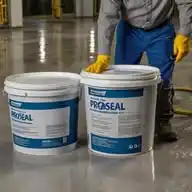
CONSTRUCTION WATERPROOFING TIPS NIGERIA
February 8, 2025 at 12:41 PM
Traumatic Damp: The Silent Destroyer of Nigerian Homes
Imagine stepping into your home after a long day, only to be greeted by musty air, peeling paint, and damp patches creeping up your walls. If this sounds familiar, you might be dealing with traumatic damp, one of the most destructive yet overlooked issues in Nigerian homes.
What is Traumatic Damp?
Traumatic damp refers to persistent moisture problems in walls, floors, and ceilings that weaken buildings, ruin aesthetics, and create an unhealthy living environment. Unlike regular dampness caused by spills or leaks, traumatic damp is deep-rooted, relentless, and can damage an entire structure over time.
Symptoms of Traumatic Damp
You don’t need a degree in construction to spot the warning signs of traumatic damp. Some common symptoms include:
✔ Peeling or bubbling paint – Walls lose their smooth finish, making them look old and unattractive.
✔ White, powdery deposits on walls (efflorescence) – A sign that moisture is drawing salt from the cement.
✔ Persistent musty smell – Even with regular cleaning, the smell lingers.
✔ Mold or mildew growth – Often appears as black or greenish patches, especially in corners or behind furniture.
✔ Cold, damp walls – Touching the walls might feel wet or unusually cold.
✔ Cracking or crumbling plaster – The structural integrity of your walls may be at risk.
Causes of Traumatic Damp in Nigeria
Damp issues don’t just happen overnight. In Nigeria, where climate and construction practices play a big role, the main causes include:
1. Rising Damp
This occurs when groundwater seeps up through walls due to a lack of a proper damp-proof course (DPC). Many old buildings in Nigeria were built without an effective DPC, making them prone to moisture rising from the foundation.
2. Poor Drainage & Flooding
Heavy rains and poor drainage systems cause water to collect around homes, eventually penetrating walls. If your house is in a low-lying area or poorly drained estate, you’re at higher risk.
3. Leaky Pipes & Roofs
A small, unnoticed leak from a plumbing line can gradually saturate your walls and floors, leading to dampness. Roof leaks are also a common culprit, especially during the rainy season.
4. Poor Construction Practices
Many Nigerian homes are built with low-quality materials or without proper waterproofing solutions. Using salt-laden sand for plastering, for example, can attract moisture and accelerate damp issues.
5. Condensation & Poor Ventilation
In many urban homes, airflow is restricted, especially in bathrooms and kitchens. This leads to condensation, where warm air meets cold surfaces, creating moisture buildup.
How to Spot Traumatic Damp Early
Catching damp issues early can save you from costly repairs. Here’s how to stay ahead:
✅ Inspect your walls regularly – Look for peeling paint, mold, or unusual damp patches.
✅ Check the smell – A persistent musty odor is often a giveaway.
✅ Look for salt deposits – White powdery substances on walls indicate rising damp.
✅ Test with aluminum foil – Tape a piece of foil to the wall overnight. If moisture forms underneath, you have a damp problem.
✅ Monitor your floor tiles – Loose, lifted, or cracked tiles can signal moisture buildup from below.
Treatment & Solutions for Traumatic Damp
1. Use High-Quality Waterproofing Products
Invest in reliable waterproofing solutions like PROSEAL Damp Cure, PROSEAL Waterproof Plaster, or PROSEAL Liquid Roof Membrane. These products seal walls, prevent moisture penetration, and protect against future damp problems.
2. Apply a Damp-Proof Course (DPC)
If your home was built without a proper DPC, consider injecting a chemical DPC treatment to stop rising damp at its source.
3. Fix Leaks & Improve Drainage
✔ Seal roof leaks before they cause major structural damage.
✔ Fix leaking pipes to prevent moisture from spreading through walls.
✔ Improve drainage by redirecting rainwater away from your foundation.
4. Replaster with Damp-Resistant Materials
If your walls are badly affected, use damp-resistant renovation plaster instead of traditional sand and cement plaster. This allows moisture to escape while preventing further damage.
5. Improve Ventilation & Airflow
✔ Open windows regularly to reduce condensation.
✔ Use exhaust fans in kitchens and bathrooms.
✔ Rearrange furniture to allow air circulation, especially in damp-prone areas.
Final Thoughts
Traumatic damp is more than just an eyesore—it’s a silent destroyer that can weaken buildings and create health hazards. Whether you’re a homeowner, landlord, or tenant, taking action early can save you thousands in repairs.
By using professional-grade waterproofing solutions like PROSEAL, improving drainage, and ensuring proper ventilation, you can keep your home dry, strong, and beautiful for years to come.
Have you experienced damp problems in your home? Share your story in the comments! #dampproofing #homemaintenance #waterproofing